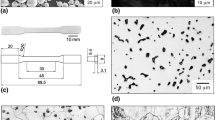Abstract
Powder injection molding (PIM) offers an attractive method for producing smart and intricate shapes components. PIM process is cost effective and equally applicable for metals and ceramics. Debinding process is the most critical step among all PIM steps and any residual during debinding can change the composition of sintered product resulting change in final properties. In this research work, the injection molded samples were thermally debound and sintered in various atmospheres. The results showed that the sintered samples with improper thermal debinding resulted the carbide formation at the surface and across the grain boundaries that caused to increase the roughness value.
Access this chapter
Tax calculation will be finalised at checkout
Purchases are for personal use only
Similar content being viewed by others
References
A. Bose, I. Otsuka, T. Yoshida, H. Toyoshima, Faster sintering and lower costs with ultra-fine MIM powders. Met. Powder Rep. 62, 18–25 (2007)
R.M. German, Powder Injection Molding: Metal Powder Industries Federation (Princeton, USA, 1990)
A. Bose, The technology and commercial status of powder-injection molding. JOM 47, 26–30 (1995)
S.T. Lin, R.M. German, Extraction debinding of injection molded parts by condensed solvent. Int. J. Powder Metall. 21, 19–24 (1989)
L. Liu, N.H. Loh, B.Y. Tay, S.B. Tor, Y. Murakoshi, R. Maeda, Effects of thermal debinding on surface roughness in micro powder injection molding. Mater. Lett. 61, 809–812 (2007)
B. Levenfeld, A. Varez, J.M. Torralba, Effect of residual carbon on the sintering process of M2 high speed steel parts obtained by a modified metal injection molding process. Metall. Mater. Trans. A 33, 1843–1851 (2002)
M.R. Raza, F. Ahmad, M. Omar, R. German, A.S. Muhsan, Role of debinding to control mechanical properties of powder injection molded 316L stainless steel. Adv. Mater. Res. 699, 875–882 (2013)
R.M. Rafi, F. Ahmad, M.A. Omar, R.M. German, Effects of cooling rate on mechanical properties and corrosion Resistance of vacuum sintered powder injection molded 316L stainless steel. J. Mater. Process. Technol. 212, 164–170 (2012)
C.H. Ji, N.H. Loh, K.A. Khor, S.B. Tor, Sintering study of 316L stainless steel metal injection molding parts using Taguchi method: final density. Mater. Sci. Eng. A311(311), 74–82 (2001)
R.M. German, A. Bose, Powder Injection Molding of Metal and Ceramics: Metal Powder Industries Federation (Princeton, NJ, 1997)
B. Berginc, Z. Kampus, B. Sustarsic, The influence of MIM and sintering-process parameters on the mechanical properties of 316L SS. Materiali in Tehnologije 40, 193–198 (2006)
S. Krug, S. Zachmann, Influence of sintering conditions and furnace technology on chemical and mechanical properties of injection molded 316L. Powder Injection Moulding Int. 3, 66–70 (2009)
H.Ö. Gülsoy, S. Salman, Microstructures and mechanical properties of injection molded 17-4PH stainless steel powder with nickel boride additions. J. Mater. Sci. 40, 3415–3421 (2005)
P. Vieira Muterlle, Microstructural and Mechanical Properties of Co and Ti Alloys for Biomedical Applications Produced by Metal Injection Molding (MIM), Ph.D. Materials Engineering, University of Trento, 2010
C. García, F. Martín, P. de Tiedra, L.G. Cambronero, Pitting corrosion behaviour of PM austenitic stainless steels sintered in nitrogen—hydrogen atmosphere. Corros. Sci. 49, 1718–1736 (2007)
Acknowledgments
The authors acknowledge the “Universiti Teknologi PETRONAS, AMREC SIRIM Kulim Kedah”, and UKM-ICONIC-2013-003 and UKM-DIP-2012-29” for providing technical and financial support.
Author information
Authors and Affiliations
Corresponding author
Editor information
Editors and Affiliations
Rights and permissions
Copyright information
© 2015 Springer Science+Business Media Singapore
About this paper
Cite this paper
Raza, M.R. et al. (2015). Effects of Residual Carbon on Microstructure and Surface Roughness of PIM 316L Stainless Steel. In: Hassan, R., Yusoff, M., Alisibramulisi, A., Mohd Amin, N., Ismail, Z. (eds) InCIEC 2014. Springer, Singapore. https://doi.org/10.1007/978-981-287-290-6_81
Download citation
DOI: https://doi.org/10.1007/978-981-287-290-6_81
Published:
Publisher Name: Springer, Singapore
Print ISBN: 978-981-287-289-0
Online ISBN: 978-981-287-290-6
eBook Packages: EngineeringEngineering (R0)



